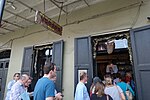On September 28, 1958, Fernando Rios, a 26-year-old tour guide from Mexico City who was working in New Orleans, died due to injuries sustained during an assault he experienced the previous night. That night, Rios had been at the Cafe Lafitte in Exile, a gay bar in the city's French Quarter neighborhood, when he began talking to John Farrell, a 20-year-old student at Tulane University. Earlier in the night, Farrell, who had been enjoying the nightlife of the French Quarter with two fellow Tulane students–Alberto Calvo and David Drennan–had recommended that the three "roll a queer", a slang term for robbing a gay man. Farrell and Rios left the bar together at around 2 a.m., with Farrell offering to give Rios a ride back to the Roosevelt Hotel, where he was staying. However, Farrell instead led Rios into the alley between the St. Louis Cathedral and the Presbytere and assaulted him, with Calvo and Drennan both present. Farrell then stole Rios's wallet and left him in the alley, where he was discovered unconscious the next morning. Rios never regained consciousness and died at Charity Hospital.
Following Rios's death, the three individuals turned themselves into the police and a murder trial commenced, with the three pleading not guilty. Their defense team employed a gay panic defense, arguing that Farrell's actions were justified because Rios had committed unwanted sexual advances on him. In January 1959, an all-white jury returned a verdict of not guilty for all three men, eliciting cheers from the crowd gathered at the courthouse. The district attorney for New Orleans later initiated another case against the three for robbery, but the litigation dragged on for several years, during which time Calvo returned to his home country of Panama and the other two moved to other states. In 1964, Drennan and Farrell agreed to a plea bargain where they pled guilty, but served no jail time, and in 1966, the district attorney's office filed a nolle prosequi regarding Calvo, ending their litigation. A wrongful death claim initiated by Rios's mother was dismissed due to violating the statue of limitations, as the attorney representing her completed the prerequisite paperwork over a year after Rios's death.
After the murder trial, which attracted a significant amount of local news coverage–much of which expressing a bias in support of the accused–the event largely faded from local memory. However, the 2017 publication of a book on the killing written by local LGBTQ historian Clayton Delery revived interest in the incident, leading to increased contemporary coverage of the event. Multiple sources have referred to the killing of Rios, a gay man, as an incident of gay bashing and a hate crime.









